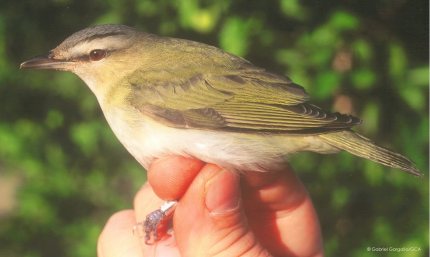Vireo olivaceus at Tiana, Maresme- 2nd for Catalunya

The Red-eyed Vireo, Vireo olivaceus at Tiana, Maresme, 30.10.2000. 2nd for Catalunya
It’s a bit surprising to read the original chronicle of the trapping and ringing of a Red-eyed Vireo (Vireo olivaceus) at Tiana, Maresme on 30.10.2000, somewhat 18 years ago. In those times the internet was beginning and so were the cell phones. Thanks to that some of us could see this stunning bird, the 2nd (and so far the last) Vireo in Catalunya.
El viri d’ulls vermells, Vireo olivaceus, a Tiana, Maresme, el 30.10.2000, 2n per a Catalunya
[És una mica sorprenent llegir la crònica original de la captura i anellament d’un viri d’ulls vermells a Tiana, Maresme, el 30.10.2000, gairebé fa 18 anys. En aquells temps l’internet començava a ser popular, el mateix que els telèfons mòbils. Gràcies a això que alguns de nosaltres vam poder gaudir d’aquesta cita espectacular, la del 2n viri d’ulls vermells de Catalunya. Fins ara ha estat l’últim que s’ha vist]
October is turning up to be a magic month in NE Spain regarding rarities. Mobile GSM phones are strictly necessary if you want to follow the latest news. So when you receive 4 calls in 5 minutes it means that something has happened. Simply, the 3rd Red-eyed Vireo for Spain, and the 2nd for Catalonia, had just been trapped in Tiana, Barcelona, just c.10 km N of the city.
Tiana holds perhaps one of the most traditional ringing stations here in Catalonia located at Can Giró property. It has been managed in agreement with the property by the GCA (Grup Català d’Anellament, the Catalan Ringing Group -now ICO, Institut Català d’Ornitologia-) which organizes campaigns there since the late seventies.
On 30.10.2000 Carles Llebaria, the ringer in charge of the station that day, trapped an unfamiliar bird which obviously was not one of the common European species. In contact with GCA office the bird was identified by phone as a Red-eyed Vireo and for further confirmation, G.Gargallo went to confirm the sighting. GCA office kindly broadcasted the news and six more observers were able to “fly-by-car” (in only one car, by the way) to the place in time to see the bird.

Identification
The identification of the bird was straightforward. A rather powerful passerine, of the size of a Garden Warbler Sylvia borin but with a shorter tail and with a strong bill reminiscent of New-World Tyrannidae: broad-based, hooked and powerful. A disctinctive head design clearly pointed the species.
The head showed an ash-grey cap with a tiny jet black border in contact with off-white supercilium. In fact the supecilium had different colours depending on the area: a white patch near the bill base, then a greyish area and a slightly buffish tone over the eye followed by an again greyish area after the eye. Lores were off black and there was a dirty white area under the eye. The rest of the face was greenish and chin was white. Nape and rest of back parts were green. Bill had a dark grey upper mandible plus a pale grey with a dark stripe lower mandible (see in-situ drawing).
Wing feathers and tail feathers were new but pointed. Tail feathers had a brown tinge with olive-green outer webs. All showed typical calendar-year growing bars (cf. Svensson 1992). Wing feathers showed lesser, median and greater coverts black with outer green edges. Primary coverts did not show such a green extent and were on average darker, only having a narrow greenish outer edge. Tertials, especially innermost, seemed browner than the rest of wing feathers, with the innermost being somewhat abraded. Secondaries and primaries were black with a greenish outer web and a pale narrow whitish edge in their tips. Underwing coverts were yellowish and undertail coverts too. All the rest of underparts were white except some tones in the sides of breast which were greenish. Flanks also slightly grey-green coloured. Legs were of a strikingly grey-blue tone. And the eye was reddish-brown.
Ageing
Ageing of this bird was straightforward following Cramp & Perrins (1994) BWP: vol VIII: the retained juvenile primaries (with whitish edges), secondaries and tertials, as well as tail feathers in contast with all moulted coverts and the adult head pattern pointed clearly to a 1st winter bird.
Origin
This bird showed a 5 fat score (Kaiser 1993 scale) which means a good condition bird. We think this bird was not directly coming from America but probably coming from the North with other incoming migrants (robins, blackcaps, warblers) and may have arrived elsewhere to N/C Europe some time ago, recover somewhere there and accumulate enough reserves to follow its “normal direction” southbound travel. But, in any case, we’ll never know the truth.
Ocurrence
This is the 2nd Catalan record after that of a juvenile found dead at Tarragona city, near the Francolí river, on 19.10.1995 (Xavier Jiménez), a record which was accepted by SEO/BirdLife Rarities Committee and was published in De Juana et al 1997. Observaciones de aves raras en España. Año 1995. Ardeola 44(1): 119-141.
Observers
All eleven (lucky) observers were: Carles Llebaria, Miquel Sánchez, Gabriel Gargallo, Sergi Sales, Cristian Jensen, Ferran López, Joan Castelló, Xavier Larruy, Joan Bécares, Marc Iranzo & Ricard Gutiérrez.
Adapted from the original publication in Rare Birds in Spain on 5.11.2000

